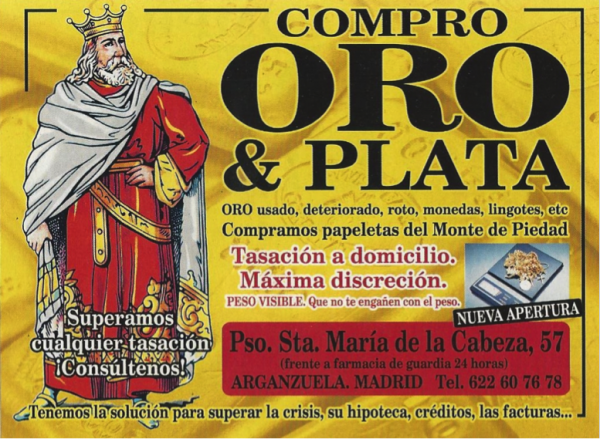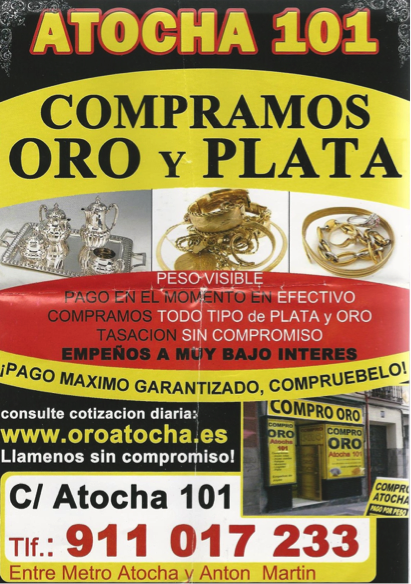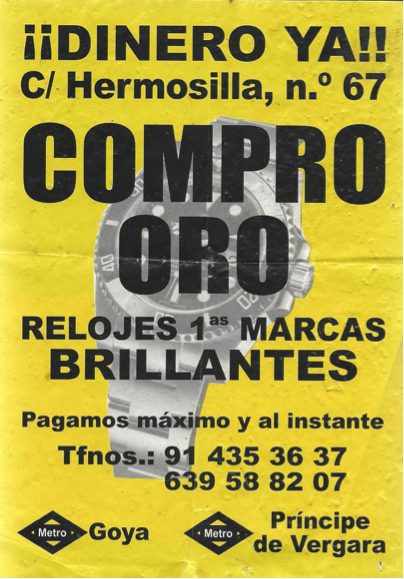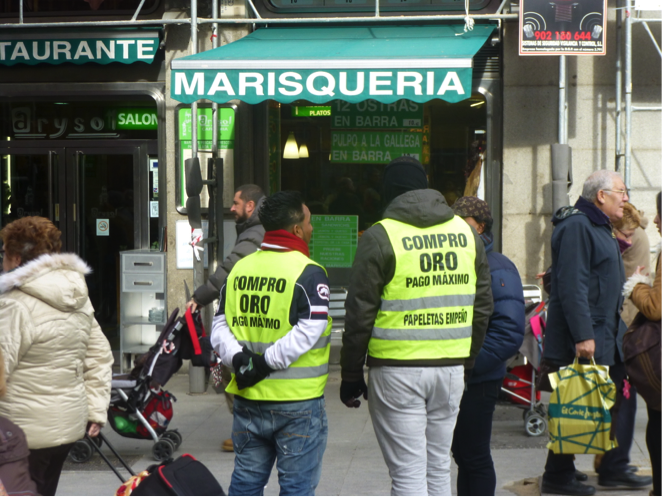Photo: Jeremy Brooks
Compro oro: cash-for-gold in times of crisis
- January 6, 2016
Capitalism & Crisis
After the 2008 crisis, cash-for-gold shops popped-up everywhere. Barragan’s book provides an intimate portrait of a business that thrives in times of crisis.
- Author
The idea for this book began with a simple question: why did the number of cash-for-gold shops skyrocket following the economic crisis of 2008, that is, during the age of austerity?
In 2010, at the height of the crisis, cash-for-gold shops tripled to nearly 500 in the southern region of Andalucia, Spain, one of the areas hit the hardest by the economic policies of austerity in the country. In Greece, the European capital of the Regime of Austerity, 90% of 224 officially registered cash-for-gold shops opened in 2010. Across the United Kingdom, “pop-up” cash-for-gold stands increasingly dotted urban and suburban shopping centers, amidst rumors of swanky “gold parties” in the living rooms of struggling English housewives. “Business is very good, you can really feel the crisis,” claimed Alexia Messi, a cash-for-gold shopkeeper in Rome, who owned seven cash-for-gold shops as of 2012.
Why bother with cash-for-gold shops? Well, as the anthropologist Daniel Miller argues in Stuff, things and objects, including the cash-for-gold shop itself, are important “not because they are evident and physically constrain or enable, but quite the opposite. It is often precisely because we do not see them. The less we are aware of them, the more powerfully they can determine our expectations.” Objects are powerful because they “work by being invisible and unremarked upon, a state they usually achieve by being familiar and taken for granted.”
This book therefore urges us to not only see and breathe life into the elusive cash-for-gold shop, but furthermore, taking the Italian shopkeeper Alexia Messi’s claim seriously, it seeks to really feel the crisis from inside the shop. And like Walter Benjamin, who asked why mirrors were being inserted into “expensive carved frames of old paintings” instead of canvases at a particular historical moment, it attempts to examine why these shops suddenly exploded after 2008 and what it means for us all.
Excerpt of Chapter 1 “Compro Oro! Dinero ya! Cash-for-Gold in Spain”
“So, do you know anyone who’s been to a compro oro shop before?”
“Pues, it’s like going to the psychologist, or better yet the soup kitchen,” said Veronica, a Spanish teacher I met in her early forties. “You don’t tell people that you need to go, because you’re ashamed, so we never know who among us has been.”
It could be anyone.  It could even be Veronica, but we’ll never know. She shrugged.
It could even be Veronica, but we’ll never know. She shrugged.
Like Veronica’s elusive response, you can’t escape the compro oro shops no matter where you go, where you turn in Spain. As of July 26, 2012, there were nearly 15,000 shops across the country. It all went haywire when the price of gold, responding to rattled investors seeking some kind of payback-stability, jumped dramatically in the wake of the economic crisis (i.e., in 2009 gold spiked from 723 Euros to 921 Euros, a 27% increase!). Once King Gold, reliable monarch that he is, manifested the might of his rule, the shops began to mushroom.
In the northern province of Galicia alone, there were more than 100 shops in 2011. A Galician shopkeeper from a compro oro store named Oro Efectivo commented that he had seen “numerous wedding and engagement rings” passing through his shop, leftover remnants of broken-up marriages and engagements, victims of the crisis. In 2009, there were 27 shops in Castile and Leon, birthplace of Queen Isabel I de Castilla, who famously backed Christopher Columbus’s mad plans westwards in search of a quick route to the East Indies. By 2010, there were 76 in the region. And heading south from Castile and Leon to Seville, where Queen Is abella received Columbus in her royal court, the 8 cash-for-gold shops in 2008 expanded to more than 200 by the end of 2012, with nearly 400 in the greater Seville province. It is said that competition between compro oro vendors in this area is so intense that shopkeepers rent out empty stores and often leave them empty just to keep competition away.
abella received Columbus in her royal court, the 8 cash-for-gold shops in 2008 expanded to more than 200 by the end of 2012, with nearly 400 in the greater Seville province. It is said that competition between compro oro vendors in this area is so intense that shopkeepers rent out empty stores and often leave them empty just to keep competition away.
And then there’s Madrid and our beloved Puerta del Sol, the heart of the Compro Oro Empire. Here, at the Gate of the Sun, there were up to 200 shops as of 2012, the largest concentration of shops in the entire country. The greater Madrid area boasted 700 shops in 2011; the highest anywhere in Spain and a giant leap from the 200 in 2007. “I came here to sell some pieces of gold,” said Rosa, a Spanish woman who sold some of her stuff at a shop at Puerta del Sol, “a necklace, a ring and a metal. You need to rip yourself apart from them because soon the payments will come, and you’ll want to get rid o f them before they rob you. I’m going to pay the water, the gas, the electricity, food, that’s what I’m going to do.” Another unnamed Spanish woman also added, “It’s a shame for me to have to sell my gold, the jewelry I had, and little by little, I have nothing left…Today I have nothing.”
f them before they rob you. I’m going to pay the water, the gas, the electricity, food, that’s what I’m going to do.” Another unnamed Spanish woman also added, “It’s a shame for me to have to sell my gold, the jewelry I had, and little by little, I have nothing left…Today I have nothing.”
“You can’t eat gold,” said María José Rigo, a cleaning lady and recent widow from the island of Mallorca, the same site of a double suicide by an elderly couple who couldn’t pay their mortgage in February 2011. In late 2010 and early 2011, María José had already sold three bracelets and four rings, but that wasn’t enough to make ends meet, especially after her husband passed away and the debts started to mount. Waking us up from this fetishistic love affair with this shiny yellow stuff, María Jose indeed reminded us, or maybe even warned us, that you can’t eat gold. But can gold eat us?
No matter whom you ask, everyone seems to have made up their mind about them, the compro oro guys. One journalist cautioned readers against seeing them as “architects [of the crisis].” Rather, he warns, they are “the paid-by-commission stewards of the recession.” Another journalist, in the same spirit, said that the compro oro guys are in fact the “thermometers of the crisis,” constantly taking the collective temperature of the bed-ridden world economy. The less you see them, so it is said, the better the financial prognosis. Good riddance boys!
But in addition to their multifaceted job description as stewards and human thermometers, they’ve also been called “soldiers of gold,” for the hours they spend in their commanding, fluorescent yellow compro oro armor drifting back and forth in front of their shops. Or perhaps this journalist saw them on horseback and mistook them for the ghostly great-great-great-great grandchildren of the long dead Rey-something-the-third. Or maybe all of us have it all wrong.
“What can I say,” said José, a compro oro guy I spoke to one chilly late December afternoon just a few steps away from Puerta del Sol, “I’m just trying to make ends meet.”
 José, one of the compro oro guys I spoke with, is from Mérida, Venezuela, a city tucked between the breathtaking Venezuelan Andes. When I asked José his thoughts about the crisis, he couldn’t help but laugh, playfully slapping my shoulder. “Hombre, en Latinoamérica, siempre hemos tenido ‘la crisis.’” (“Man, in Latin America we’ve always had ‘the crisis.’”)
José, one of the compro oro guys I spoke with, is from Mérida, Venezuela, a city tucked between the breathtaking Venezuelan Andes. When I asked José his thoughts about the crisis, he couldn’t help but laugh, playfully slapping my shoulder. “Hombre, en Latinoamérica, siempre hemos tenido ‘la crisis.’” (“Man, in Latin America we’ve always had ‘the crisis.’”)
Yes—I wanted to nudge him in that cold-silly-social-scientist kind of way—but when did this seemingly infinite crisis begin, Jose? When exactly? Can you give me a specific day, month, and year please? (According to Marxist economist Christian Marazzi, the shift from Fordism to post-Fordism occurred exactly on October 6, 1979, so such calculations aren’t totally out of the question). Can you offer me anything, José?
No?
Okay, fine, just a year will do for now. So then, José, what year did it all go wrong? 2008? Or maybe 1982, when the Mexican debt crisis set off Latin America’s rapid economic decline, eventually paving the way for the neoliberal regime of the 1990s?
Or is it that you want me to push back farther, deeper? (Will you be able to pull me up from out of here, from the cracks of the earth?)
Is it 1558?
“I’ve been here about six years now,” he says, quickly pulling me up out of the hole, “Of course people are still selling their gold with Christmas and all, to buy some toys for the kids, but about two or three years ago, there were more people selling, going to compro oro shops…it’s not like that anymore, it’s like everyone has sold most of their gold already.” Yes, it is true, there is only so much gold to go around, being the shiny physical substance that it is.
We’re running out of time, and things to share (quite frankly), so in between his occasional shouts of Oro! Oro!, José offers his last words, “What else can I tell you, about my time out here.” He laughs. “It’s just damn cold!” But, who knows, he says, why don’t you talk to my co-worker, pointing to a tall, black man with a New York Yankees cap a few feet away from us. After thanking him, I walk over.
“¿Hola, cómo estás?” I start off, before going off into my typical slightly-awkward-yet-cheerful introduction of my project on the crisis and cash-for-gold. He’s an older man, perhaps in his late forties, and soon I discover from his accent that he’s from DR, the Dominican Republic. At first, he seemed to have welcomed me openly with a friendly smile, but immediately after I gave him the lowdown of my curiosity, his face turned stone cold. “We can’t talk to you about these things, not in front of the shop, about our customers, I don’t know why José told you those things.” He looked off angrily towards José, who was busy passing out leaflets to passing shoppers, huffs of warm air emptying out into the cold winter breeze.
I tried to explain that I was only interested in his experience working for the shop, nothing confidential, but I soon realized that I had lost him. And now I’m worried that I may have jeopardized José’s job. Shit. A few seconds later, a young Spanish couple approach him, say a few things to him in a very low voice, and he immediately escorts them to the shop upstairs and doesn’t look back.
Anyway, I had better luck a few days later. That afternoon, I met Alejandro, an older man who was wearing a black baseball cap and thick blue sweatshirt under his compro oro vest while standing in a plaza just off Puerta del Sol. “You’re Ecuadorian aren’t you?” he said to me almost immediately, with a sly smile. “I could tell from your face, the roundness of your mouth.” My mouth? We quickly bonded after he discovered that my father was from the port city of Guayaquil, his hometown.
He traveled that long distance between Guayaquil and Madrid nearly 10 years ago, in 2002 to be exact, before the infamous Madrid train bombings in 2004. “It was easier to come before that,” he said, “the bombings changed everything.” But more than the bombings, he added, the economic crisis really shifted the destinies of so many Ecuadorians living in Spain. “All the ecuatorianos I know are either leaving to go back home to Ecuador, to France, or the United States. It’s gotten so bad here.”
“A few years ago,” he said towards the tail end of our conversation, “I used to make 2,000 sometimes up to 3,000 Euros a month in the construction business.” After the housing crash in 2008, those jobs are no longer an option. “So I’m stuck here with my wife and our two children. A ver que pasa (Let’s see what’s going to happen).” 2,000-3,000 Euros a month. That’s quite different from the 1,000 Euros that many compro oro guys get paid in ‘good months.’ Temporary workers, they work on contracts that can last as long as three months.
Before parting ways, Alejandro shared some of the little English that he knew—“the beautiful lady”—with a bit of a wink. Yeah, I got the message. While pulling out his business card, he also made me promise to find him a book that would help him learn English “quick.” “You know, English can help me leave, I gotta get back home.”
But unlike Alejandro, one of the last compro oro guys I spoke to the following day, who didn’t offer his name but nevertheless spoke to me for a bit, seemed to be trying to stay away, far, far away from home. A tall, black man with a very visible long scar on his forehead, he was wearing a thin jacket—even though it was still pretty cold—under his compro oro uniform. I couldn’t catch his eyes hiding behind his flashy, dark sunglasses. And although he didn’t want to talk to me for very long, he did offer little bits of himself.
“Yes, it’s true what people say that la gente come up to me crying, saying they don’t want to sell their necklaces or rings, all kinds of people, rich and poor…” He looked off in the opposite direction.
“Your accent, you’re from Colombia, yeah?” I asked.
For a moment I had his attention. “Yes, yes, I’m from Cali,” he said, a major city in southwestern Colombia known for its world-famous salsa and beautiful women. There was an inexplicable longing in his voice. “Oh, hey,” I responded, “My mom’s from Pereira,” another city just north of Cali, and in the heart of the country’s famous coffee district. “And I’m a historian too, I’m writing about the abolition of slavery in Colombia, in el Chocó on the Pacific Coast, I spent some time in Chocó, in Quibdó, Istmina, Tadó, Andagoya…”
There was a brief moment of recognition. The names of familiar towns seemed to have awakened something between us. “Well, actually,” he paused looking at me, this time straight in the eye. “I’m really from Buenaventura,” a major port city on the southern Pacific coast of Colombia, “…well, a fishing village just outside of Buenaventura…” He looked off beyond me.
And just like that, just for a moment, we were both suddenly standing together, in silence, looking out from a small window in a waterfront shack on the outskirts of Buenaventura, looking out towards the expansive, dark blue Pacific Ocean. It’s hot, but the occasional breeze from the ocean cools us off temporarily. Gunshots are set off in the distance—turf wars between the drug lord’s paramilitaries and members of Manuel Cepeda Vargas Urban Front, a cell of the FARC (Revolutionary Armed Forces of Colombia, the famous guerrilla group) in Buenaventura’s slums. In 2007, around the same time, give or take, that he left Colombia, Buenaventura was crowned the deadliest urban center in Colombia’s long civil war.
And then we’re back again, standing in Puerta del Sol where we both shiver a bit in the cold, thousands of miles away from that quiet room on the coast.
“That’s a long ways away, I can only imagine, no?”
“Pues,” he sighs, “es muy complica’o, muy complica’o…”
And he’s right. It is all very complicated. Very complicated.
This is an excerpt of the book Selling Our Death Masks: Cash-For-Gold in the Age of Austerity, published by Zer0 Books.
A radical historical ethnography on the meaning of a fundamentally new physical landscape of our age of austerity: cash-for-gold shops that numerically exploded in the wake of the worst economic crisis of our times.
Source URL — https://roarmag.org/essays/selling-death-masks-cash-for-gold-excerpt/



